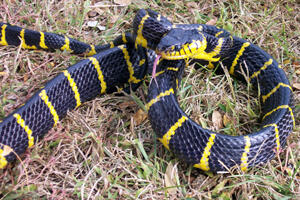Sept. 27, 2006
Toxic snake venom to fight human disease
A research team, led by VCU affiliate professor, discovers the first species-specific toxin
Share this story

Deep in Southeast Asia’s lowland rainforests and mangrove swamps, a predator lurks. He slithers along the far-reaching arms of a mangrove tree, swiftly moving into position to launch his attack. The mangrove catsnake, large, black in color, and patterned with bright yellow bands, has a big appetite for birds. He’ll use his deadly venom to paralyze his victim. But while the snake’s venom will ultimately kill its prey, researchers are studying how its venom may be used to develop therapeutic drugs that may save human lives.
One such researcher is R. Manjunatha Kini, Ph.D., a professor in the Department of Biological Sciences at the National University of Singapore, and an affiliate professor in the Department of Biochemistry at Virginia Commonwealth University. For Kini, who grew up in India, a childhood fascination and curiosity with venomous animals bloomed into his life’s work and a quest to find new ways to fight human afflictions such as cancer and cardiovascular disease.
For the past 27 years, Kini and his team have been studying toxins, particularly snake venom toxins, to understand structure-function relationships and mechanism of action. Kini has been up-close and personal with a variety of venomous creatures – including Boiga dendrophila, or the mangrove catsnake.
“Snake venoms are cocktails of pharmacologically active proteins and peptides. Some of these toxins help us as highly specific molecular scalpels in deciphering molecular mechanisms of normal physiological processes. A number of these toxins could also help us in developing therapeutic agents for the treatment or prevention of human diseases,” said Kini.
In a recent study, published in the September issue of the Journal of Biological Chemistry, Kini and his team identified a new snake toxin called denmotoxin, a major component from the venom of the mangrove catsnake. Using protein chemistry and molecular biology techniques, they isolated and identified the novel toxin from the snake venom, and characterized it for its structure and biological properties. They described denmotoxin as a small, stable cysteine-rich protein, which consists of 77 amino acids. Kini said that the protein toxin folds into three loops, and was classified as the three-finger toxin family.
“Denmotoxin is the first species-specific toxin that has been fully characterized. Because the mangrove catsnake preys primarily on birds, its primary toxin has evolved to target birds,” said Kini. “We have also determined its three-dimensional structure so we can compare its structure with other neurotoxins.”
“Denmotoxin has a great potential to become a model for a better understanding of toxin mechanisms of species-specificity, as well as reversible binding of venom neurotoxins,” he said.

Kini said that denmotoxin targets the nerve-muscle junction of birds with great efficiency, but it does not show significant effects on mouse (mammalian) nerve-muscle junction. Kini’s team demonstrated that denmotoxin of the mangrove snake potently and irreversibly blocks nicotinic acetylcholine receptors in chick nerve-muscle junction, causing paralysis and death to the bird prey. Additionally, they found that a significantly high dose of the denmotoxin - more than 100 times - is needed to partially block mouse nerve-muscle junction. Kini said that the toxin does not strongly interact with the mouse receptor and can easily be reversed.
In other work, Kini and his team have developed a number of anticoagulant, antiplatelet and anti-hypertensive agents based on snake venom toxins that may one day prove useful in the treatment or prevention of cardiovascular and cerebrovascular disease. These agents are currently being tested in the lab. They have also developed an analgesic peptide and a number of therapeutic peptides including anti-angiogenic activity for use in the treatment of cancer, based on the structure of human proteins.
The mangrove catsnake belongs to the snake family known as colubridae, which consists of approximately two-thirds of the described species of the advanced snakes and includes more than 700 species of venomous snakes. Kini said that colubrid snakes are sometimes considered non-venomous snakes because they produce small amounts of venom and do not possess an obvious venom apparatus, such as front fangs. Unlike cobras or vipers, which have the venom gland and fangs in front of their mouths, the mangrove catsnake has rear fangs, as do others in the colubrid family.
“A better understanding of the components of colubrid venom may one day lead to the discovery of new bio-active compounds. With the advances in technology, we can now study proteins found in small amounts. These studies indicate that colubrid venoms consist of novel proteins with exciting new biological properties,” said Kini.
“New drug leads are always important in improving quality of our lives. Denmotoxin may help us develop a bird-specific neurotoxin or develop nerve agents that do not affect humans and other mammals,” he said.
Kini’s studies have opened several new and exciting avenues in toxin research. He looks with great anticipation for the day when this research can provide more answers to transform the deadly toxins into life-saving agents.
The work published in the Journal of Biological Chemistry was supported by a grant from the Biomedical Research Council at the Agency for Science, Technology and Research in Singapore.
Kini collaborated with Joanna Pawlak, a doctoral student in Kini’s lab at the National University of Singapore; Madhav Bhatia, Ph.D., associate professor in the Department of Pharmacology at the National University of Singapore; Bryan G. Fry, Ph.D., deputy director of the Australian Venom Research Unit in Melbourne; Stephen P. Mackessy, Ph.D., professor of biological sciences at the University of Colorado; André Ménez, Ph.D., director in the Department of Protein Studies and Engineering and president of the French Museum of Natural History, and International Society of Toxinology; and researchers Gilles Mourier, Ph.D., Carole Fruchart-Gaillard, Ph.D., Denis Servent, Ph.D., Renée Ménez, Ph.D., Enrico Stura, Ph.D., all with the Département d’Ingénierie et d’Etudes des Protéines, Commissariat à l’Energie Atomique in France.
Subscribe to VCU News
Subscribe to VCU News at newsletter.vcu.edu and receive a selection of stories, videos, photos, news clips and event listings in your inbox.







